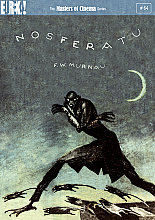Free Membership
Welcome to DVD-Movie-Sale.co.uk!
DVD Movie Sale is a comprehensive DVD site where you can search for any movie by genre, film title, actors name or director. Complete with full film information & synopsis as well as being able to compare prices for your favourite DVD from leading retail stores. You even have the opportunity to include your personal film reviews or give your personal ratings with numerous chances to win dvd related prizes.
Browse DVDs
Nosferatu (The Definitive Fully-Restored Version)
Nosferatu (The Definitive Fully-Restored Version)
 Stars: Max Schreck, Alexander Granach, Gustav Von Wangenheim, Greta Schroeder
Stars: Max Schreck, Alexander Granach, Gustav Von Wangenheim, Greta SchroederDirector: F.W. Murnau
Summary: The original full-length fully restored version of the silent horror classic. Also features the trailer 'Shadow Of The Vampire'. The feature on Disc 2 is tinted.
F.W. Murnau's silent classic is the original, and some say scariest, DRACULA adaptation, taking Bram Stoker's novel and turning it into a haunting, shadowy dream of German Expressionist horror and dread. Count Orlok, the rodentlike vampire frighteningly portrayed by Max Schreck, is perhaps the most animalistic screen portrayal of a vampire ever filmed. The design was copied by Werner Herzog in his 1979 remake and by Tobe Hooper for his telefilm of Stephen King's SALEM'S LOT that same year. Names had to be changed from the novel when Stoker's wife charged his novel was being filmed without proper permission. Charged with now-legendary cinematic imagery, NOSFERATU is a landmark of the horror genre that should not be missed.

WIN DVDS by being amongst the first to review this DVD. Reviewing DVDs earns you bonus entries and lets you WIN DVDs!Please login before reviewing this DVD. If you're a new user, register for free and enter to WIN FREE DVDs!

 "Nosferatu ... the name alone can chill the blood!". F.W. Murnau's Nosferatu, released in 1922, was the first (albeit unofficial) screen adaptation of Bram Stoker's Dracula. Nearly 80 years on, it remains among the most potent and disturbing horror films ever made. The sight of Max Schreck's hollow-eyed, cadaverous vampire rising creakily from his coffin still has the ability to chill the blood. Nor has the film dated. Murnau's elision of sex and disease lends it a surprisingly contemporary resonance. The director and his screenwriter Henrik Gaalen are true to the source material, but where most subsequent screen Draculas (whether Bela Lugosi, Christopher Lee, Frank Langella or Gary Oldman) were portrayed as cultured and aristocratic, Nosferatu is verminous and evil. (Whenever he appears, rats follow in his wake.)
"Nosferatu ... the name alone can chill the blood!". F.W. Murnau's Nosferatu, released in 1922, was the first (albeit unofficial) screen adaptation of Bram Stoker's Dracula. Nearly 80 years on, it remains among the most potent and disturbing horror films ever made. The sight of Max Schreck's hollow-eyed, cadaverous vampire rising creakily from his coffin still has the ability to chill the blood. Nor has the film dated. Murnau's elision of sex and disease lends it a surprisingly contemporary resonance. The director and his screenwriter Henrik Gaalen are true to the source material, but where most subsequent screen Draculas (whether Bela Lugosi, Christopher Lee, Frank Langella or Gary Oldman) were portrayed as cultured and aristocratic, Nosferatu is verminous and evil. (Whenever he appears, rats follow in his wake.)
The film's full title--Nosferatu, eine Symphonie des Grauens (Nosferatu, A Symphony of Horror)--reveals something of Murnau's intentions. Supremely stylised, it differs from Robert Wiene's The Cabinet of Dr Caligari (1919) or Ernst Lubitsch's films of the period in that it was not shot entirely in the studio. Murnau went out on location in his native Westphalia. As a counterpoint to the nightmarish world inhabited by Nosferatu, he used imagery of hills, clouds, trees and mountains (it is, after all, sunlight that destroys the vampire). It's not hard to spot the similarity between the gangsters in film noir hugging doorways or creeping up staircases with the image of Schreck's diabolic Nosferatu, bathed in shadow, sidling his way toward a new victim. Heavy chiaroscuro, oblique camera angles and jarring close-ups--the devices that crank up the tension in Val Lewton horror movies and edgy, urban thrillers such as Double Indemnity and The Postman Always Rings Twice--were all to be found first in Murnau's chilling masterpiece. --Geoffrey Macnab

| Aspect Ratio: | 4:3 Full Frame |
| Region: | Region 2 |
| Special Features: | Audio commentary by film-critics Brad Stevens and R Dixon Smith, 96-page book, 53 minute German documentary focusing on Murnau, Restoration demonstration |
| Year: | 1921 |
| Release Date: | November 19, 2007 |
| Runtime: | 93 minutes |
| Certification: | |
| Catalogue Number: | E K A 40214 |
| Keywords: | General, Nosferatu, Horror, Occult |
| Genre: | Horror/Occult |






















